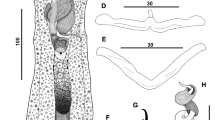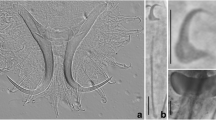Abstract
Combined morphological and molecular analyses are used to characterise two new species of Haplorchoides Chen, 1949 (Digenea: Heterophyidae) from an Australian siluriform fish. Haplorchoides maiwariensis n. sp. and H. daguilarensis n. sp. are described from the intestine of the Blue salmon catfish, Neoarius graeffei (Kner & Steindachner) (Siluriformes: Ariidae) from tidal reaches of the Brisbane River and from a freshwater creek off Lake Wivenhoe, Kipper Creek, Australia. The two new species most obviously differ from all previously described species of Haplorchoides in possessing clearly and reliably tripartite seminal vesicles. The two new species differ in the size and distribution of vitelline follicles, the size of the pigment granules and the form of the ventral sucker. Previously described species of Haplorchoides have been reported from Africa and Asia, principally from bagrid, schilbeid, silurid and sisorid catfishes; these are the first species reported from an ariid catfish. Complete ITS2 and partial 28S ribosomal DNA data were generated for both new species. The two species differ from each other by eight base pairs in the ITS2 region, and by 13 bp for the 28S region. The 28S rDNA sequence of H. daguilarensis agrees with a previously reported sequence from an unidentified species of Haplorchoides collected from N. graeffei in Lake Wivenhoe, Australia; we identify this previous report as relating to H. daguilarensis.


Similar content being viewed by others
References
Agrawal, P. K., & Agrawal, S. M. (1981). Life history of Haplorchoides vacha sp. nov. (Trematoda: Heterophyidae) from the intestine of Eutropiichthys vacha (Ham.). Rivista di Parassitologia, 42, 185–190.
Agrawal, V. (1964). On some trematodes from fresh water fishes of Lucknow. Indian Journal of Helminthology, 16, 82–98.
Anderson, G. R., & Barker, S. C. (1998). Inference of phylogeny and taxonomy within the Didymozoidae (Digenea) from the second internal transcribed spacer (ITS2) of ribosomal DNA. Systematic Parasitology, 41, 87–94.
Ankenbrand, M. J., Keller, A., Wolf, M., Schultz, J., & Förster, F. (2015). ITS2 Database V: Twice as much. Molecular Biology and Evolution, 32, 3030–3032.
Bhadauria, S., & Dandotia, M. R. (1986). Studies on the digenetic trematodes of freshwater fishes with special reference to Gwalior region. Rivista di Parassitologia, 3, 353–397.
Chatterji, P. N. (1957). Two new fish trematodes of the family Heterophyidae Odhner, 1914. Proceedings of the National Academy of Science, India, Section B, 26, 347–355.
Cribb, T. H., Anderson, G. R., Adlard, R. D., & Bray, R. A. (1998). A DNA-based demonstration of a three-host life-cycle for the Bivesiculidae (Platyhelminthes: Digenea). International Journal for Parasitology, 28, 1791–1795.
Cribb, T. H., & Bray, R. A. (2010). Gut wash, body soak, blender and heat-fixation: approaches to the effective collection, fixation and preservation of trematodes of fishes. Systematic Parasitology, 76, 1–7.
Cribb, T. H., Bray, R. A., Littlewood, D. T. J., Pichelin, S. P., & Herniou, E. A. (2001). The Digenea. In: Littlewood, D. T. J. & Bray, R. A. (Eds), Interrelationships of the Platyhelminthes. London, UK: Taylor & Francis, pp. 168–185.
Dayal, J. (1935). Studies on the trematode parasites of Indian fishes. Proceedings of the Indian Academy of Science, 2, 403–409.
Dayal, J. (1949). Trematode parasites of Indian fishes, Part II. Indian Journal of Helminthology, 1, 93–120.
Dhanumkumari, C. (2000). On a new species of digenetic trematode Haplorchoides wallagoi (Trematoda: Heterophyidae) from cat fishes of Visakhapatnam, India. Rivista di Parassitologia, 16, 197–202.
Edgar, R. C. (2004). MUSCLE: multiple sequence alignment with improved accuracy and high throughput. Nucleic Acids Research, 32, 1792–1797.
Froese, R., & Pauly, D. (Eds) (2017). FishBase: World Wide Web electronic publication. http://www.fishbase.org, version 10/2017.
Gupta, P. C., & Govind, H. (1985). Three species of trematode parasites of the genus Haplorchoides Chen, 1949 from fresh water fishes of Kanpur, India. Indian Journal of Parasitology, 9, 35–39.
Gupta, P. C., & Gupta, S. P. (1979). On two avian trematode parasites (family Heterophyidae Odhner, 1914) from Kanpur. Indian Journal of Helminthology, 29, 73–78.
Gupta, P. C., & Singh, R. B. (1986). Studies on digenetic trematodes of Indian fishes and birds. Kanpur University Research Journal (Science), 3, 23–36.
Gupta, S. P. (1955). Trematode parasites of fresh-water fishes. Indian Journal of Helminthology, 5, 1–80.
ICZN (2012). International Commission on Zoological Nomenclature: Amendment of articles 8, 9, 10, 21 and 78 of the International Code of Zoological Nomenclature to expand and refine methods of publication. Bulletin of Zoological Nomenclature, 69, 161–169.
Keller, A., Schleicher, T., Schultz, J., Müller, T., Dandekar, T., & Wolf, M. (2009). 5.8S-28S rRNA interaction and HMM-based ITS2 annotation. Gene, 430, 50–57.
Khalil, L. F., & Thurston, J. P. (1973). Studies on the helminth parasites of freshwater fishes of Uganda, including the descriptions of two new species of digeneans. Revue de Zoologie et Botanique Africaines, 87, 209–248.
Littlewood, D. T. J. (1994). Molecular phylogenetics of cupped oysters based on partial 28S rRNA gene sequences. Molecular Phylogenetics and Evolution, 3, 221–229.
Littlewood, D. T. J., Curini-Galletti, M., & Herniou, E. A. (2000). The interrelationships of Proseriata (Platyhelminthes: Seriata) tested with molecules and morphology. Molecular Phylogenetics and Evolution, 16, 449–466.
Littlewood, D. T. J., Rohde, K., & Clough, K. A. (1997). Parasite speciation within or between host species? Phylogenetic evidence from site-specific polystome monogeneans. International Journal for Parasitology, 27, 1289–1297.
Lockyer, A. E., Olson, P. D., Ostergaard, P., Rollinson, D., Johnston, D. A., Attwood, S. W., et al. (2003). The phylogeny of the Schistosomatidae based on three genes with emphasis on the interrelationships of Schistosoma Weinland, 1858. Parasitology, 126, 203–224.
Looss, A. (1896). Recherches sur la faune parasitaire de l’Egypte. Première partie. Mémoires de l’Institut égyptien (Egypte), 3, 1–252.
Manpratum, Y., Kaewkes, W., Echaubard, P., Sripa, B., & Kaewkes, S. (2017). New locality record for Haplorchoides mehrai and possible interactions with Opisthorchis viverrini metacercariae in cyprinid fishes in Northeast Thailand. Parasitology Research, 116, 601–608.
Mehra, H. R. (1980). The fauna of India and Adjacent Countries. Platyhelminthes. Volume 1. University of Allahabad, India: Manager of Publications, Government of India for the Zoological Survey of India.
Morgan, J. A., & Blair, D. (1995). Nuclear rDNA ITS sequence variation in the trematode genus Echinostoma: An aid to establishing relationships within the 37-collar-spine group. Parasitology, 111, 609–615.
Olson, P. D., Cribb, T. H., Tkach, V. V., Bray, R. A., & Littlewood, D. T. J. (2003). Phylogeny and classification of the Digenea (Platyhelminthes: Trematoda). International Journal for Parasitology, 33, 733–755.
Pande, B. P., & Shukla, R. P. (1976). Haplorchoides Chen, 1949 (Haplorchinae: Heterophyidae) in freshwater fishes. Journal of Helminthology, 50, 181–192.
Pearson, J. (2008). Family Heterophyidae Leiper, 1909. In: Gibson, D. I., Jones, A. & Bray, R. A. (Eds), Keys to the Trematoda, Volume 3. Wallingford, UK: CAB International and the Natural History Museum, pp. 113–142.
Pleijel, F., Jondelius, U., Norlinder, E., Nygren, A., Oxelman, B., Schander, C., et al. (2008). Phylogenies without roots? A plea for the use of vouchers in molecular phylogenetic studies. Molecular Phylogenetics and Evolution, 48, 369–371.
Pornruseetairatn, S., Kino, H., Shimazu, T., Nawa, Y., Scholz, T., Ruangsittichai, J., et al. (2016). A molecular phylogeny of Asian species of the genus Metagonimus (Digenea) -small intestinal flukes - based on representative Japanese populations. Parasitology Research, 115, 1123–1130.
Rai, P., & Pande, B. P. (1967). Observations on the haplorchine flukes hitherto known from Indian siluroid fishes. Agra University Journal of Research, Science, 16, 17–24.
Rizvi, S. S. H. (1971). Digenea of Pakistan freshwater fishes I: Haplorchoides sindicus new species family Cryptogonimidae from the intestine of Mystus aor (Ham.), Sukkur, West Pakistan. Pakistan Journal of Scientific and Industrial Research, 14, 518–520.
Sambrook, J., & Russell, D. W. (2001). Molecular Cloning: A Laboratory Manual. Cold Spring Harbor, NY: Cold Spring Harbor Laboratory Press.
Sándor, D., Molnár, K., Gibson, D. I., Székely, C., Majoros, G., & Cech, G. (2017). An investigation of the host-specificity of metacercariae of species of Apophallus (Digenea: Heterophyidae) in freshwater fishes using morphological, experimental and molecular methods. Parasitology Research, 116, 3065–3076.
Scholz, T. (1991). Observations on trematode fauna of freshwater fish in Laos. Helminthologia, 28, 125–130.
Shameem, U., & Madhavi, R. (1988). The morphology, life-history and systematic position of Haplorchoides mehrai Pande & Shukla, 1976 (Trematoda: Heterophyidae). Systematic Parasitology, 11, 73–83.
Shumenko, P. G., Tatonova, Y. V., & Besprozvannykh, V. V. (2017). Metagonimus suifunensis sp. n. (Trematoda: Heterophyidae) from the Russian southern Far East: Morphology, life cycle, and molecular data. Parasitology International, 66, 982–991.
Singh, H. S., Chaubey, S., Singh, S. C., Jaisawal, D. K., & Maurya, N. K. (2010). Haplorchoides ashakoa sp. nov. (Trematoda: Heterophyidae) from a fish Mystus vittatus (Day.) from Gomati River Jaunpur. India. Journal of Experimental Zoology India, 13, 581–582.
Singh, K. (2010). Haplorchoides hunamanthai sp. nov. (Digenea: Heterophyidae: Haplorchinae) from fresh water fish Colisa fasciatus (Cuv.Vol) from River Gomti, Jaunpur (U.P). India. Journal of Experimental Zoology India, 13, 137–138.
Snyder, S. D., & Tkach, V. V. (2001). Phylogenetic and biogeographical relationships among some Holarctic frog lung flukes (Digenea: Haematoloechidae). Journal of Parasitology, 87, 1433–1440.
Srivastava, H. D. (1935). Studies on the family Heterophyidae Odhner, 1911, Part II: Four new parasites of the genus Haplorchis Looss, 1899, from Indian fresh-water fishes with a revision of the genus. Proceedings of the Academy of Science, Uttar Pradesh, Agra and Oudh, 5, 75–85.
Tamura, K., Stecher, G., Peterson, D., Filipsk, A., & Kumar, S. (2013). MEGA6: Molecular Evolutionary Genetics Analysis version 6.0. Molecular Biology and Evolution, 30, 2725–2729.
Zaidi, D. A., & Khan, D. (1977). Digenetic trematodes of fishes from Pakistan. Bulletin of the Department of Zoology, University of the Punjab, 1, 1–56.
Acknowledgements
We sincerely thank Ms Hoi Yan Iao, Mr Nicholas Q-X. Wee and Mr Yat Long Angus Li for their assistance with the collection of fish specimens from the Brisbane River and Lake Wivenhoe, and Mr Arnault Gauthier for providing the fishing location at Lake Wivenhoe.
Funding
THC and SCC acknowledge the Australian Biological Resources Study (ABRS) for their ongoing support. This study was funded by the ABRS National Taxonomy Research Grant RF215-40.
Author information
Authors and Affiliations
Corresponding author
Ethics declarations
Conflict of interest
The authors declare that they have no conflict of interest.
Ethical approval
All applicable institutional, national and international guidelines for the care and use of animals were followed.
Additional information
This article was registered in the Official Register of Zoological Nomenclature (ZooBank) as urn:lsid:zoobank.org:pub:5C476750-0DE3-4A25-9E36-3CFEF76685CD. This article was published as an Online First article on the online publication date shown on this page. The article should be cited using the doi number. This is the version of record.
This article is part of the Topical Collection Digenea.
Rights and permissions
About this article
Cite this article
Hostettler, R., Cutmore, S.C. & Cribb, T.H. Two new species of Haplorchoides Chen, 1949 (Digenea: Heterophyidae) infecting an Australian siluriform fish, Neoarius graeffei Kner & Steindachner. Syst Parasitol 95, 201–211 (2018). https://doi.org/10.1007/s11230-018-9775-3
Received:
Accepted:
Published:
Issue Date:
DOI: https://doi.org/10.1007/s11230-018-9775-3




